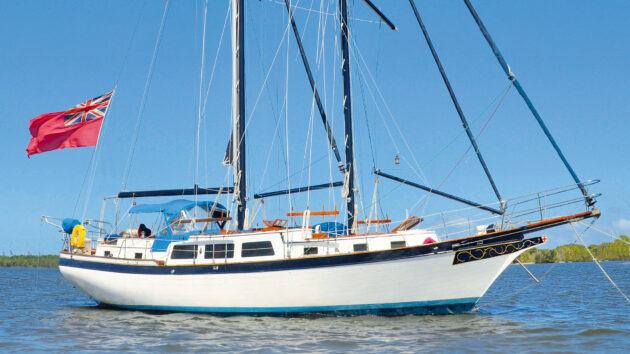A heavy anchor chain can cause problems for your crew and your yacht’s performance moving it aft can help
The chain locker in Britannia’s bow was totally inadequate for the 250ft (76m)of 3/8-inch chain I considered to be a bare minimum for my 22-tonne boat. Every time we weighed anchor, and even when only part of the rode had been laid, the chain would always pile up in the locker and jam the windlass.
Someone then had to scramble over the forward cabin bunks, open the locker’s equally inadequate little door, then push the pile of wet chain over to one side to allow the remainder of the chain to be fed in. Sometimes this had to be done more than once, and it became extremely tiresome, especially when my wife and I were the only two aboard.
The reason the chain wouldn’t self-stow was because the bow locker was in the steep vee-shaped part of the bow and the chain had no room to spread out as it piled in. There was nothing that could be done to enlarge this space, but every time it happened I swore I would somehow try to re-route the chain into one of the large compartments under the fo’c’sle bunks.

The original chain locker was too small for the amount of chain needed to anchor Britannia, often resulting in a jammed windlass
Redirecting the chain
The compartments under the fo’c’sle bunks were certainly big enough to accommodate all of the chain and they were only ever used for the storage of spare pipes and lines that we hardly ever bothered with because they were so difficult to get to.
I knew that if I could relocate the chain there would be an important additional benefit; our 250ft (76m) of 3/8-inch chain weighs in at around 420lb (190kg), therefore the further aft the chain could be stowed, the lighter the bow would become, and it’s always better to keep weight on a boat’s extremity to a minimum – at both ends – in order to reduce pitching.
There were two large compartments under the forward cabin bunks, the after-most one being the widest and deepest. This was 84cm (33in) deep and 53cm (21in) fore and aft and spanning the width of the hull. It also had a solid GRP floor which would be an ideal platform, because the chain would be able to spread a lot better on the wider flat surface.
The question then was, how to direct the chain into this larger compartment? It was 4ft (1.22m) further aft of the existing anchor chain locker and I wouldn’t be able to run a tube directly from the navel-hole into the new locker because it would pass straight through the middle of the double bed.

There were two large compartments under the fo’c’sle bed that weren’t easily accessed without dismantling all the bedding
Continuous feed
When I installed a new Maxwell electric windlass to replace the old manually operated one I positioned it on top of the bowsprit. The chain then ran smoothly from the bow roller, round the windlass gypsy and down through the navel-hole (the hole leading from the deck into the chain locker).
Its related tube, the hawse-pipe, is the pipe leading from the deck to the outside of the boat, but not many sailboats have hawse-pipes nowadays because their anchors are normally stowed on a bow roller. The only route for the chain, therefore, was down through the existing locker, around an almost 90º curve and along a tube under the bunks.
But although the locker was more than big enough, would the chain then continuously feed in under its own weight?

A test rig was set up to calculate the optimum angle for getting the chain to self-feed down through the pipes
The chain easily rolled off the gypsy (sprocket wheel that grips and pulls in the chain), then down into the original chain locker because it was a vertical drop. However, getting it into the new locker meant it would need to pass through a curved pipe and travel a further 1.14m (45in) along a tube, to finally fall into the centre of the new compartment.
The long tube would therefore need to be angled downward enough to help overcome friction as the chain slid along it, then it would need to have a deep enough fall at the end, for the weight to haul the rest of the chain in a continuous automatic feed.
I had no idea what sort of slope would be required, or how much fall the chain would need to continuously drag itself through this pipework. And I couldn’t experiment with the angle of the pipes in the actual fo’c’sle because the 50mm (2in) diameter tube had to pass through a bulkhead between the two compartments – and I didn’t know where to drill the large hole.

New holes had to be cut into both the forward bulkhead and the bulkhead between the two large compartments
Suitable angle
There was only one way I could think of to determine a suitable angle. I assembled a crude mock-up, using some 50mm (2in) diameter plastic conduit pipe that’s normally used for plumbing in houses.
It is amazingly strong stuff, with a wall thickness over 3mm (1/8in) and very rigid when connected together. I bought it from our local hardware store for around £8, including a curved joint.
I used my workbench and a step-ladder to hold the tubes. The downpipe which would pass through the old locker was 86cm (34in) long while the pipe to carry the chain into the centre of the new compartment was 114cm (45in) long.
Article continues below…
The mock-up looked very amateurish but it gave me a very good idea of what sort of angle would be needed. I used 15m (50ft) of chain out of the aft anchor locker, the same size as the bow chain, and fed it through the tubes. After a bit of adjustment I found that a minimum slope of approximately 10º would allow the chain to run continuously as I fed it into the top pipe.
I took some measurements and transferred them to where the hole would have to be cut into the bulkhead between the two compartments to carry the pipe.
Installing the new pipes
Before I could install anything I had to haul all the anchor chain off the boat and pile it up on the marina pontoon in order to give a clear working space. Luckily, the plywood base of the bunks had only been screwed to the beam structure underneath, so I removed the complete starboard side section, which gave me much more space to work in.

Previous tasks saw Roger reposition Britannia’s masts to turn her into a brigantine schooner
I marked where the hole needed to be in the intervening bulkhead and cut a hole using a 64mm (2½in) hole cutter. I also had to greatly enlarge the tiny drain hole in the bottom of the original chain locker to be able to position the 5cm (2in) diameter curved pipe. I didn’t want this to show above the 15cm (6in) bed foam, so I made it as low as possible.
I found it impossible to use a solid pipe to connect the navel hole on the deck to the curved pipe below because the angles were completely misaligned. A length of flexible lorry fuel filler tubing with a 50mm (2in) internal diameter was just right. I was able to join it directly to the 50mm (2in)-round flange on the navel-hole pipe using a jubilee clip, then clamped the other end to the curved pipe at the bottom of the locker. This gave the chain a perfect lead into the curved pipe.
Having installed all the tubing I still couldn’t be sure if it would actually eliminate the chain backing up. I’d used only a small length of chain in my simulation test, but as a much longer length piled up in the locker the distance it had to fall would reduce. So the question was, would the fall still be enough to continue to self-feed right to the last link? There was only one way to find out…

Access to the chain is now very easy, without disturbing the fo’c’sle bedding, or even the occupants
Perfect fall
As I assembled the pipework I ran a 6mm (1/4in) rope through the middle to enable me to pull the first links through the tubes. I passed this line over the windlass gypsy and tied it to the first link then easily pulled the chain through the complete tube and shackled it to a hefty eye-bolt that I had screwed through the locker bulkhead.
The maximum fall, from the end of the pipe to the bottom of the new locker, was 70cm (27in) – and the first lengths of the chain landed bang in the centre of the locker.
The base of the new compartment was flat so I was hopeful that this would allow the chain to collapse itself from a larger pyramid pile. Thankfully, this proved to be the case because all the chain ran into the new locker on its own, every last link!

The chain piled up exactly in the centre of the new locker
Cunning plan
In the original layout, seawater coming in on the chain, which can be substantial especially with a full-length rode, drained down the slope of the bow then aft into the bilge. I was confident that the re-routing had solved this vexing problem, but, of course, you never know on boats. So I made a further alteration.
If the chain ever banked up and jammed again, the only way to knock the pile over would be to move the bulky bed foam, with all the sheets, covers, and pillows, lift the locker door and reach down into the deep space to knock the pile over. This would be just as much of a nuisance as before, but I had a plan to be able to get to the chain pile easily and quickly.
The rear of the new compartment formed the back of the removable seat between the vee berths. I cut a large aperture in this panel, which offered immediate access to the chain compartment without having to disturb the bunks. This hole didn’t need a door, because the seat-back cushion covers it. It just needed a trim around the exposed edges.
When I put the foam mattress back I had to slice a taper out of the bottom of the foam to eliminate a bump over the curved pipe, which is now completely undetectable when the bed is made up.

Finished job. Why didn’t Britannia’s original designer think of this?
Self-feeding success
Britannia now has a totally self-feeding anchor chain system that hasn’t failed so far, even on the rare occasions when I’ve anchored using all the chain.
I did receive one complaint, however, from the first guests who used the fo’c’sle. They said it sounded like an earthquake when we weighed anchor one morning. But I didn’t pay much notice, because they should have been helping on deck as we got the ship under way.
On the plus side, Britannia’s bow has come up about an inch now that the heavy anchor chain has been located further aft. That might not sound much, but it has certainly reduced inertia as Britannia’s bow ploughs into head seas.
If your boat’s chain locker won’t accept all of your anchor chain without you having to knock the pile over, and you manage to fix it in a similar way, it will come as a big relief every time you weigh anchor – and all that chain disappears, mysteriously, on its own.
Enjoyed reading this?
A subscription to Yachting Monthly magazine costs around 40% less than the cover price, so you can save money compared to buying single issues.
Print and digital editions are available through Magazines Direct – where you can also find the latest deals.
YM is packed with information to help you get the most from your time on the water.
-
-
- Take your seamanship to the next level with tips, advice and skills from our experts
- Impartial in-depth reviews of the latest yachts and equipment
- Cruising guides to help you reach those dream destinations
-
Follow us on Facebook, Twitter and Instagram.





